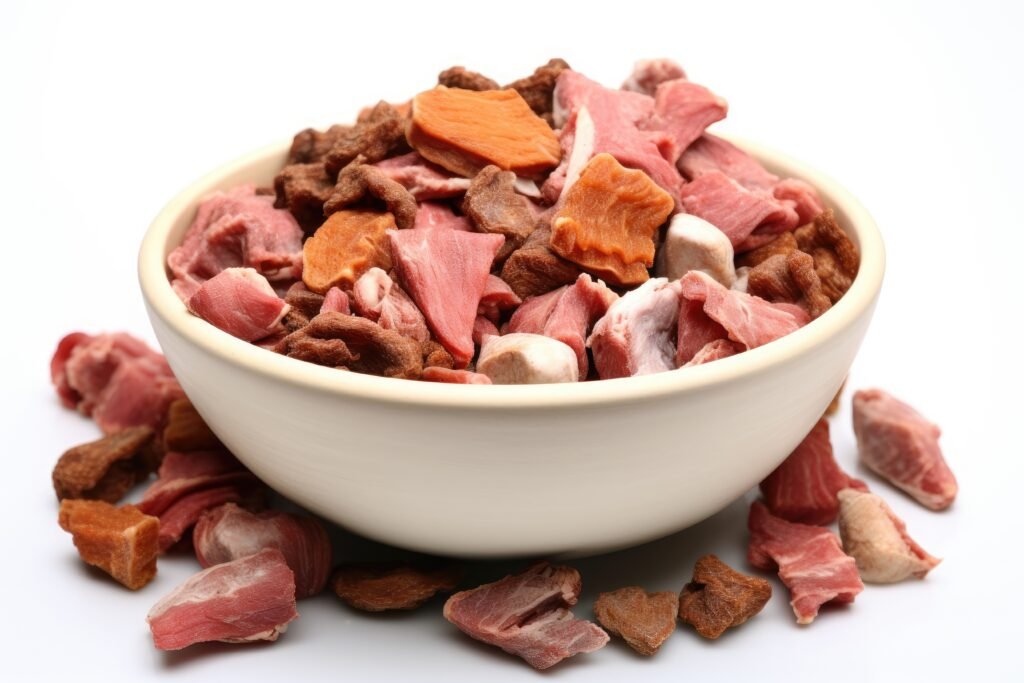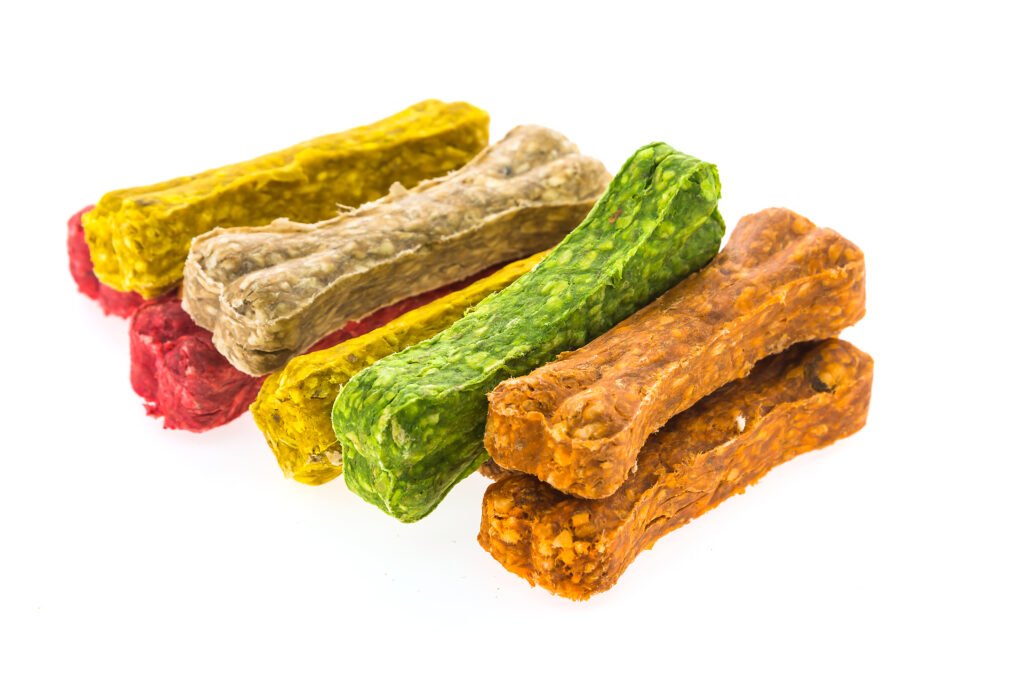Frozen Dog Food, as the title of this paper suggests, seeks to explain why many people prefer frozen dog food when it comes to pet feeding. Here, a lot of information is provided – what exactly frozen dog food is, how it may differ from dry or canned food, and various health advantages your pet can get from it. It explains the nutritional benefits and how it aids digestion, and it’s perfect for dogs suffering from allergies or sensitivities. It also advises selecting the right frozen dog food, feeding it safely, and preparing it at home.

Table of Contents
Introduction to Frozen Dog Food
This has been so as people develop increased sensitivity to the health and well-being of their dogs and, therefore, prefer natural pet food more than any other. Out of all these choices, frozen canine meals have become my favourite since they are so much healthier and processed in a minimal way. But what is frozen dog food, and why is it becoming more popular now? If you are wondering how this product can help your pet, then you will learn all about it in this comprehensive guide, which will cover the basics of frozen dog food products, including the benefits, how to store them, and how to get the right product.
What is Frozen Dog Food?
Frozen dog food is fresh dog food that has been preserved through freezing. It consists of whole, minimally processed ingredients—often raw or lightly cooked—that are frozen to lock in nutrients and freshness. Unlike kibble, which undergoes high-heat processing that can degrade its nutritional value, or canned dog food, which requires preservatives to stay shelf-stable, frozen dog food maintains the integrity of its ingredients through freezing. This ensures your dog gets a meal as close to fresh as possible, loaded with essential vitamins, minerals, and proteins.
In What It’s Different from Kibble and Canned Food
Dry and canned foods have been leading the pet foods market mostly because of their ease of use and longer shelf life. However, the products that fall into these categories are very processed, which robs them of many natural nutrients. Besides, they contain preservatives, filler agents, and artificial additives due to the desire to prolong the storage time. In contrast, frozen dog food is stored at cool temperatures and does not require added preservatives but retains the nutrient value of the food components. This makes it a more balanced and more natural way through which you can feed your dog.
Benefits of Frozen Dog Food
This frozen dog food has many advantages, making your dog healthier and happier throughout the year. Below are some of the key advantages:
Nutritional Superiority
The first reason that pet owners use frozen food is because it contains more nutrients than processed ones. Frozen dog foods, because they are made from fresh meat and are preserved by freezing, will contain a substantial amount of nutrients lost in making extruded kibbles. Vitamins, minerals, and essential fatty acids are not destroyed; benefits may include better skin and coat condition and improved immune systems in dogs.
Improved in the Digestive System and General Health
The food is much easier to digest because there are few additives and preservatives in preparing frozen dog food. While it is true that many dogs have a hard time eating a frozen diet, dogs that have some form of food sensitivity, allergic reactions to foods, or any digestion problems will do much better on this diet. Switching to a cleaner, more natural diet is likely to improve your stools, knock out tummy troubles, and enhance energy levels.
Enhanced Taste and Freshness
Dogs, by their design, are carnivores, and they generally have a soft spot for fresh meat flavours. Frozen dog food is generally tastier than kibble or canned food because the food is not cooked or processed, so the ingredients are fresher. This makes it suitable for fussy eaters who refuse to consume dry or canned food.ProsconsOf the benefits of wet food, there are some disadvantages as highlighted below. Disadvantages of Wet FoodIt is relatively expensive compared to the dry food type.

Retained Nutrients
Low Impact, High Outcome
Another obvious advantage of frozen dog food is its ability to retain the nutrients present in natural ingredients. Because the food is not exposed to the high temperatures that are used to make kibble, when preparing the food, these nutrients including the Vitamins A, D,, and E,, and the omega fatty acids are not damaged. These nutrients are vital in your dog’s skin, coat, joint,s and immune system health. Freezing is also the best way to preserve food; you do not need to add preservatives and other chemicals.
In What Way Locks Freezing Functions in Necessary Vitamins
Freezing reduces deterioration by arresting the conversion of food into undesirable and poisonous substances by enzymes. It also means that frozen dog foods contain vitamins, minerals, and antioxidants in their natural state, making the food nutrient-rich for your dog. However, the hot process of making kibble impairs these delicate nutrients and thus results in less nutritious food.
Improved Digestion
Less Processed, More Natural
Dogs are genetically programmed to consume foods that contain high proteins, fats, and little Carbohydrates. One sad thing is that many commercial dog foods contain grains and fillers that can be problematic for the dog’s digestion process. Frozen dog food, however, is usually enhanced with quality meat and vegetables but devoid of any unhelpful additives. This makes the diet more natural and may help you experience less bloating, gas, or loose stools.
Minimum Effects on Allergies and Sensitiveness
Nourishment is important, and many dogs are allergic to certain grains they are fed as a part of commercial kibble, which includes wheat, corn, and soy. This is true because most manufacturers of frozen dog foods do not include such ingredients in their foods, while they give your dogs something quite natural that can be easily digested. Therefore, pet owners have seen relief from symptoms such as itching, hot spots, and digestive problems when they feed their pets frozen food.
Why Switch to Frozen Dog Food?
Switching to frozen dog foods will help bring a huge difference to your dog’s health status. Here are some compelling reasons why you should consider making the switch:
Fresher Ingredients:
Aside from this, frozen dog food contains better quality and is supplied with fresh ingredients compared to processed kibble and canned food. The freezing process preserves the food’s flavour, taste and quality without using chemicals.
Transparency in Sourcing and Ingredients:
Many frozen dog food manufacturers boast of sourcing their ingredients from where they can find quality human consumable ones. This specificity in sourcing helps you understand precisely what your dog is taking, which puts the heart at ease for anxious pet owners.
Fewer Preservatives and Additives:
Because freezing helps to preserve products, artificial preservatives and chemicals are not added. This implies that there are reduced potential toxins added in processed pet meals and a much healthier meal, which is what your pet requires.

How to Choose the Best Frozen Dog Food
It can be challenging to decide which of the numerous kinds of frozen dog food is available. Here are some tips to help you make the best choice:
The labels and the list of ingredients
It is extremely important to always check labels like any other food meant for pets, just like with other pet foods. It is preferable to go for frozen dog food with real meat, chicken, beef, or lamb as the first item on the list of ingredients. Do not feed your dog foods that contain terms like by-products, unnamed meats,, or lots of items made from corn, soy,, or wheat.
Understanding the Situational Include of the Dog
Due to variations in size, breed, age,, and health state of the dogs they have varied feeding requirements. For instance, growing by adult and very active dogs will need more protein and fats than other dogs, while less active or old dogs need much less fat and energy-rich feed. Select a frozen dog food that will cater to your dog’s nutritional requirements it has.
Avoiding Harmful Ingredients
The prohibited additives may include artificial colours, flavours, preservatives, and high salt or sugar content. These ingredients provide no nutritional value and, in the long run, play a big role in chronic diseases such as obesity, diabetes, and heart disease.
Look for High-Quality Proteins
Why Proteins Are Essential
Protein on the other hand is all important in a dog’s diet as it helps in the building of muscles, repairing tissues,, and generating energy. You still need to look at the labels on the best-frozen dog foods and see that the first ingredient is an animal protein such as chicken, beef, turkey, or fish. Refrain from products that contain plant-derived proteins or meats, such as meat by-products, because they are inferior products.
Protein Access to the Best Frozen Dog Foods
Search for one labelled as ‘frozen dog food’, with whole meats or fish at the beginning of the list of ingredients. Chicken, turkey, beef, mutton, fish, and other sources such as salmon or sardines are the best protein sources. These offer amino acids that are very important for your dog’s diet.
Beware of Fillers and Additives
Common Additives to Avoid
Many additives commonly used in commercial dog foods are starchy grains such as corn, soy, and wheat. These fillers are completely non-essential and, in some cases, they may even cause digestive disorders, as well as allergic reactions in dogs. Also, treat artificial preservatives, colours, and flavours that are dangerous to the dog’s health.
Why Are Fillers Bad for Your Dog’s Health
Some ingredients added to many dog foods are fillers and cheap, but they don’t give your dog any nutrients. The goal, once again, of these ingredients is not to deliver beneficial nutrients to the pet’s body but to make up the volume of food. This, in turn, can cause overeating, increased weight gain, and complications in the digestive system.
Transitioning Your Dog to Frozen Food
The essential thing to remember is that changing your dog’s food should be done in small steps so as not to stress the dog’s stomach. Here’s how you can make the transition smooth and easy:
Gradual Transition Process
First, moistening a small amount of the frozen dog food with your dog’s current food is recommended. During 7-10 days, gradually mix the frozen portion while reducing the amount of old food. This helps the dog’s digestive system sort out what is needed from the new diet and stop the digestive problems often associated with a diet change.
Supervising Your Dog’s Reaction
Owners should keep their eyes on their canine’s behaviour and faeces during the change process. Whether it is discomfort, loose stools, vomiting, or both, reduce the rate of changing your dog’s diet in any way seen below. After the complete transition, you should see enhanced vitality, a shinier coat, and firmer stools in your dog.
Adjusting Portion Sizes
Although most commercial frozen dog foods contain more nutrients than kibble, you must decrease the portions a little. Most brands recommend feeding your dog according to weight and activity, but it is still advised to consult your veterinarian.

Storage and Handling of Frozen Dog Food
When it comes to frozen dog food, one should take some very important precautions to ensure that that particular type of food is safe and retains its freshness. Here are some tips:
Proper Storage Tips
The serving of frozen dog food should be prepared from the frozen food to prevent spoilage of the other foods and also from the same freezer. If frozen, it should be thawed under refrigeration and again should be used within a few days. Never let your food sit at the bottom of the freezer because that can cause a freezer burn.
Frozen dog food could be given since it is safer than giving raw food to canines. The following are ways of thawing the food safely.
The best way to thaw frozen dog food is to place it in the refrigerator or out of the freezer. Do not use the room temperature for thawing food because this will only encourage the growth of bacteria. In case you want the dishes fast, you can use the microwave to thaw the food, but you should not cook with it since it will reduce nutrient content.
Avoiding Contamination
Tips on Food Safety
Touch frozen dog food like raw meat – using gloves and washing your hands immediately afterwards. Ensure you wash your hands before and after touching the food and wash other items that come into contact with it. It minimises the spreading of bacteria and ensures that the food you feed your dog is healthy for consumption.
Preventing Bacteria Growth
In preparing frozen dog food, it is important to ensure that it is properly thawed and should not be consumed when frozen because it may contain bad bacteria. After the food has thawed, do not expose it to room temperature any longer than absolutely necessary. Throw out any foods that have been at room temperature for more than two hours.
Cost Considerations
Is making food for your dog more expensive than using the Frozen Dog Food?
Indeed, as a rule, it is costlier than kibble or canned food because of the extremely delicious and superior quality of the products and the fact that they are frozen. Still, a large number of people agree that the financial advantages that come with the use of the system are minor compared to other benefits where the pet’s disease and the rates of its visits to veterinaries and improved future health are concerned.
Balancing Cost with Quality
Although you might agree that, in most cases, frozen dog food is significantly more expensive, you do not necessarily need to buy it exclusively. Some owners feed their dogs frozen food with kibble, believing that they can feed their dogs quality food without spending too much money. Furthermore, a high-quality, nutrient-packed, tasty diet may well be in the frozen form, and one advantage of this would be eating less food in larger volumes, therefore making a point that you buy these foods at a higher cost.
Making Your Frozen Dog Food at Home
If you are daring and want a unique way of feeding your dog a homemade meal, preparing its own homemade frozen dog food is a perfect solution to provide your dog with fresh, quality and natural ingredients appropriate to his/her nutritional requirements.
DIY Frozen Dog Food Recipes
Here’s a simple recipe to get you started:
Ingredients:
1 lb ground turkey or chicken
1 cup cooked brown rice
1/2 cup shredded carrots
1/2 cup chopped spinach
1 tablespoon fish oil
Instructions:
Serve the turkey or chicken until it’s fully cooked. Combine the cooked meat with the rice and vegetables and add the fish oil. Portion the mixture and place it in air-tight containers ready for use. Stored at below 32°F, place the containers in the fridge and thaw a portion as desired. This recipe contains good protein, fibre, and other essential fats.
Conclusion
Frozen dog food is an appropriate feeding method for wholesome species and has many advantages over conventional kibble or canned food feeds for your dog. While it may be slightly more costly than packaged dry food or canned dog food, it is worth it to feed the dog well. Frozen dog food – You could purchase it from the nearest supermarket or make one at home; this diet is ideal for any dog owner who wants his or her pet to receive the best quality diet.
FAQs About Frozen Dog Food
Is frozen dog food safe?
For the most part, frozen dog food is safe, provided it is stored and thawed correctly. It is necessary to adhere to the recommendations published by the manufacturers to store and subsequently avoid contamination.
If my dog is already old, can I now feed my dog with frozen food?
Absolutely! Most senior dogs can readily obtain good quality nutrition and find better digestion when provided with frozen dog foods. As long as you gradually incorporate them into your diet it would be best if you did not have any adverse effects on your digestive system.
This is the most FAQ I have received, and I will address it in detail: How long does frozen dog food last?
In the freezer, packed dog food should stay for many months, but it is better to refer to the pack insert for exact time limit info.
Can you freeze dog food once it has been thawed?
No, you should never allow your frozen dog food to thaw and then return to the freezer because it is unhealthy. It is recommended that the florets be thawed in the quantity used in a week so that it doesn’t spoil.
Is there a higher price tag associated with frozen foods for dogs?
Yes, frozen dog food is often more costly per portion than kibble, but the many health benefits, including fewer trips to the vet and more energy, make up for the difference.


1 thought on “Frozen Dog Food: A Comprehensive Guide to Healthier, Happier Pets”